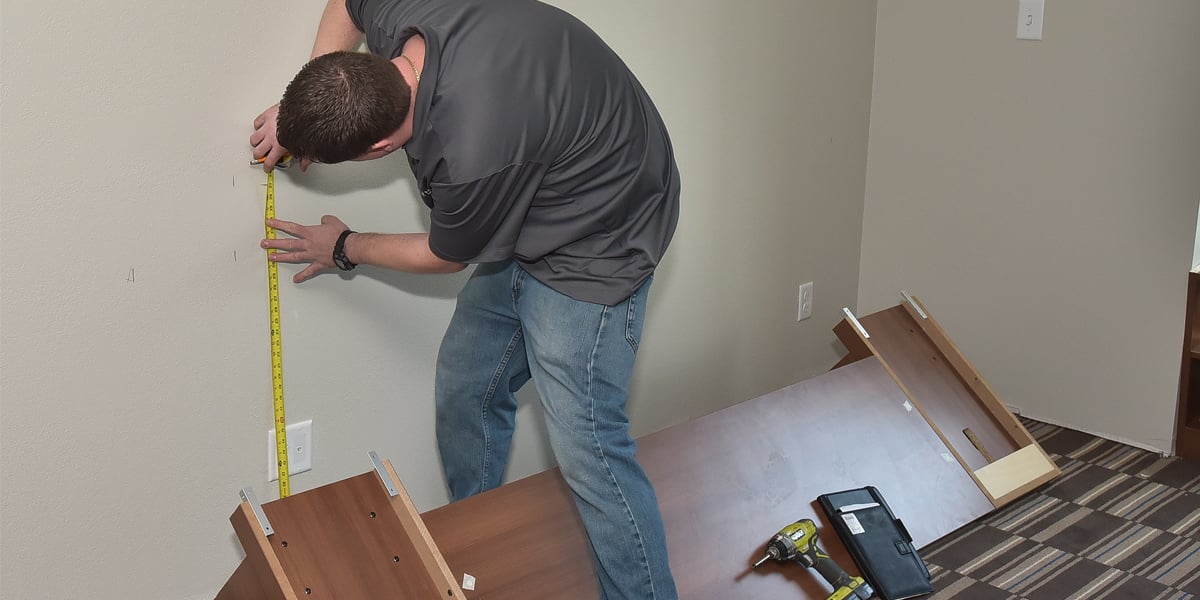
Imagine being one of NASA’s lead scientists, preparing to send the Curiosity Rover to Mars.
After years of testing, planning, and carefully managing the budget, the rover is minutes from launch. But then, someone realizes that the mechanical arms weren’t installed, and no one noticed until this moment.
The mission will now have to wait, requiring additional time and funds to reschedule and prep for another day.
In the same way, working with hotel FF&E installers on a hotel construction or renovation project requires careful planning and coordination among all involved.
Synchronized efforts between hotel FF&E installers and furniture vendors ensure a seamless journey for casegoods, from the production line to the guest room.
5 Ways to Help Your FF&E Installer’s Job Easier
A component of hospitality logistics, FF&E installation is a process you can help shepherd along by working hand-in-hand with your hospitality furniture vendor.
How? These five ways:
- Communicate
- Complete a pre-installation survey
- Get renderings and model rooms
- Agree on a schedule
- Create a day-of attack plan
1. Communicate
Establishing open lines of communication with your FF&E installer is the most important thing you can do.
Nothing sets a project off on the wrong foot like a lapse in communication. And, continued communication breakdowns only set the stage for or unnecessarily prolong issues.
Communication isn’t just about the ability to speak to one another. It’s also about making sure you understand each other. From the onset of working together, both you and your FF&E provider should be in sync on everything with your project, from expectations to potential impediments.
Remember: communication is a two-way street. If your hotel casegood provider leaves you feeling left in the dark on where things stand, speak up. The same goes for your casegoods provider with you. In other words, neither of you should feel out of the loop.
It’s good to have a designated point of contact to interface directly with your FF&E installer. Should anything come up, there’s no wasted time connecting the right people.
2. Complete a Pre-Installation Survey
A scouting mission of sorts, a pre-installation survey made long before your casegoods are built gives your FF&E installer a lay of the land. With a firsthand look at your property, they’re able to figure out exactly how to get your order to where it needs to be.
During a pre-site survey, make sure your furniture installer is taking note of:- General building layout
- Door and hallway dimensions
- Stairwell and elevator locations
- Room dimensions & layout
- Staging & storage areas
- Access points to the property
- Any potential hazards/impediments
- Electrical outlets and wiring
- Blocking and wall supports
3. Get renderings and model rooms
Once the initial site survey is complete, request photo-realistic renderings or a model room setup from your FF&E provider.
Renderings allow you to visualize the room layout and see how each piece will fit into the space. This visual preview is a powerful tool for catching potential issues early, such as furniture that may not fit as planned or layouts that don’t leave enough room for comfortable movement.
A model room setup takes it further by giving you a physical representation of the final look. With a tangible model room, you can see whether furniture aligns with the design vision and make any needed adjustments before full production begins.
This is also a great opportunity to confirm that casegoods fit as intended, from door frames to hallways, and that spacing is appropriate throughout the room.
4. Agree on a Schedule
With a set schedule, your FF&E arrives and is installed when it should be, causing little interruption to the rest of your project or operation.
For the FF&E installer, a clear, defined schedule streamlines planning of:
- FF&E production
- Deliveries
- The amount of manpower needed for installation
When creating your FF&E schedule, be as honest and realistic as possible. An overly ambitious timeframe -- or one that doesn’t match progress -- adds needless chaos or costly delays to your project.
An experienced FF&E installer is a great resource for making sure your schedule is feasible. Having completed hotel casegood deliveries and installations at other facilities, they’ll know what to expect and how to navigate the unexpected.
5. Create a Day-of Attack Plan
Taking an even more refined approach to creating a schedule, having an itinerary of the day(s) when your FF&E finally arrives on-site helps the installation process move along.
A point-by-point schedule keeps everyone on the same page as your FF&E reaches its final destination. Plus it reduces needless disruptions to the work at hand -- you’ll minimize interferences.
Frequently Asked Questions about Hotel FF&E InstallersHere are some of the most frequently asked questions about hotel FF&E installers. How early should I involve the hotel FF&E installer, and at what stages?It's a good idea to involve your hotel FF&E installer as early as possible, ideally during the initial planning stages of the project. Early collaboration allows the installer to provide insights on logistics, timelines, and spatial considerations, which can prevent issues later on. Their input is helpful during the design and pre-production phases, as they can advise on layout, access points, and any structural needs, such as wall blocking for casegoods. By involving them in these stages, the installer will be familiar with the site by the time production and delivery are in progress, allowing for a smooth installation process. How should I handle unforeseen delays or changes to the FF&E schedule?Unforeseen delays or changes in the FF&E schedule are common in large-scale projects, so flexibility and open communication are important. If a delay occurs, reach out to your installer and any relevant vendors immediately to discuss rescheduling options. It’s helpful to keep a buffer in your project timeline for such occurrences, allowing you to adjust without major setbacks. Document all changes and updates in the project timeline, and keep an open line of communication with the installer, letting them know of any new timelines or adjustments. Some installers may also have backup solutions or alternate timelines to help accommodate shifts in the schedule. What should be included in a detailed day-of installation plan?A detailed day-of installation plan should outline each step and responsibility for the installation process to keep everyone aligned and minimize disruptions. Start with a clear, point-by-point schedule that lists the arrival times for deliveries, setup times, and specific areas of the site where installers will work. Designate key contacts and assign roles so that issues can be quickly addressed. Include contingency plans for common installation-day problems, such as restricted access to certain areas or last-minute changes in room layouts. Ensure the plan accounts for any building rules or restrictions that could impact the timeline, such as restricted elevator usage or limited hours for installation work. By preparing for these details in advance, you’ll help create an organized installation day. |
Creating a Drama-Free Installation for Your FF&E Provider
Getting hotel casegoods from the assembly line to their rightful place at your hotel is no small feat -- there are plenty of moving parts to be aware of. Working with your hotel casegood installer throughout the entire process -- from the FF&E procurement process to installation -- ensures your furniture isn’t the reason for delays and overruns.
what goes on while your casegoods are being made?
Even though your hotel casegoods manufacturer is doing the heavy lifting to make your order a reality, you still play an important role in keeping it on track. Download and explore our Custom Hospitality Furniture Production Timeline for Scheduling, Planning & Tracking:
Editor's Note: This article was originally published in June 2021 and was updated in October 2024 to reflect current industry trends.

